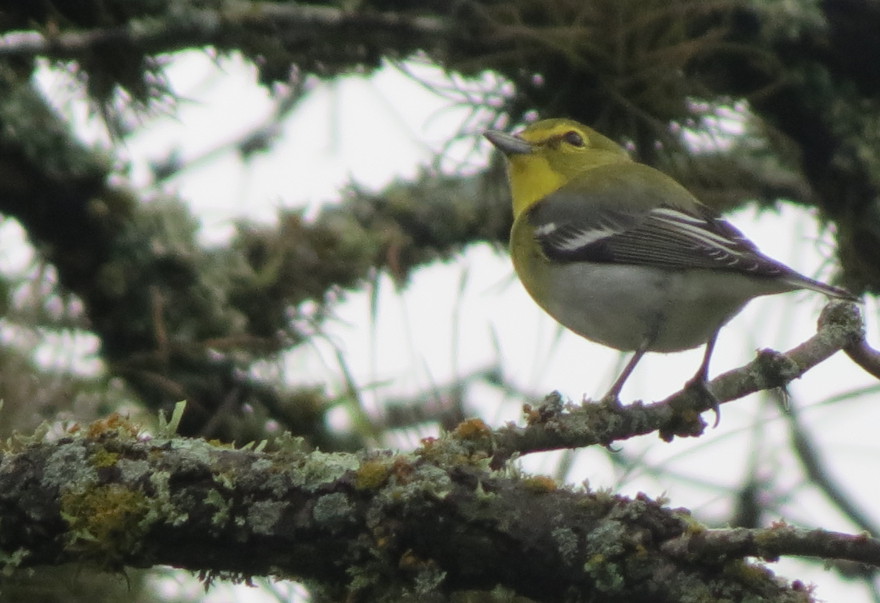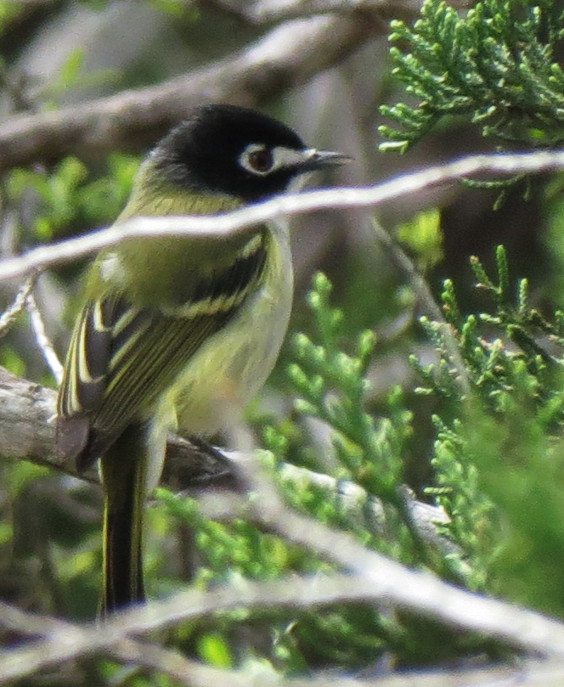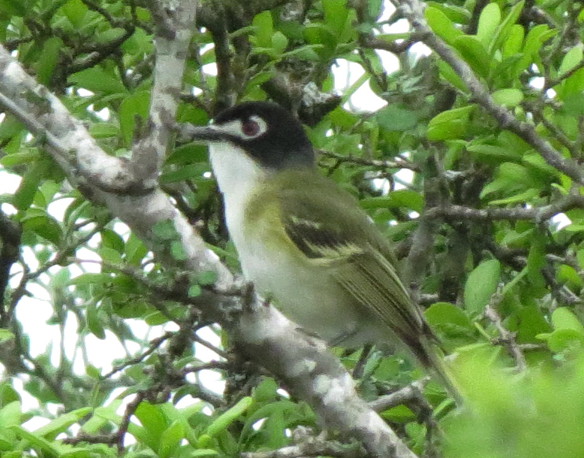© 2023 - All Rights Reserved

The Vireos of Utopia
Vireo means 'I am green', and so they are. Most an olive green, some brighter, some duller, and some are grayer green. A few are fairly gray and some vireos have yellow too. Long thought to be close to warblers, they are not. They have hook-tipped bills and Shrikes are close relatives. They glean insects and arthropods from foilage, branches and twigs in a fairly deliberate manner. They can be very fast, agile, and active when going after said tasty morsels. They are very vociferous, once their songs and calls are learned you will hear five or ten times as many as you will see. Some like the open canopy of big leafy trees, others the dense interiors of the thickest tangles and scrub. They typically splash-bathe, diving into water on the wing and do not wade into it and splash about like other birds when bathing.
There is a great variety of vireos here, we are in a veritible vireotopia. At Lost Maples I have listened to six species of vireo singing at a time, more than once. While each has distinct calls and songs, some sometimes mimic others. White-eyed can do great short bits of Black-capped Vireo song. I have encountered Red-eyed and Yellow-throated Vireo singing the others song. They can also learn the wrong song as juveniles in the nest, because the other type is nesting nearby. Vireos in general sing a lot and loud. They can be nearly incessant when nesting, and are the most likely birds to continue singing through the heat of the day.
For identification, learn that bill shape of vireos, biggish and thickish for their size, with bluntish curved tip with a small hook. No other small birds in the trees here have this. Then the usual big easy sorts amongst them are: wingbars or not, head pattern details of eyering, or spectacle, or eyeline, then, how yellow is it and where? These items will sort most of them out. Once you learn their sounds most that you encounter will be ID'd long before you see them.
Here, even non-birders have at least heard of one vireo, the Black-capped Vireo, since it is threatened. That and thousands of birders per year come to the Edwards Plateau looking to see one, many getting lost and ending up in the Utopia area asking for directions. The male, to me, is the most striking vireo of them all. The most stunning, it is a real beauty. It is also one of the most difficult to see songbirds in North America. For many it pops up top a bush or short tree and sings in the open, for others it does what they do best. Makes a living inside the center of densest thickest short often nearly impenetrable vegetation. By comparison the Golden-cheeked Warbler is a gimmie. You will probably have to work to see a Black-capped Vireo well.
So let's have a look at our vireos. We have collected all the vireo pix scattered about the web site and added ten more. Here we show 8 sps. so far, and will add more pics in time.
~ ~ ~ ~
First our only year-round resident vireo.
~ Hutton's Vireo

Hutton's Vireo Oct. 6, 2019. This is a real dull vireo, and, the only year-round permanent resident vireo here. They were never recorded here prior to the 1990's. The first record was a 1990-91 nest in Real Co. Then 3 in 1999 were the next records on the Edwards Plateau. Now they are uncommon residents. The more you know their call, the more there are. Note eyering thin in front, thick in rear, and none on top of eye is typical.

Hutton's Vireo can be confused with Ruby-crowned Kinglet. They look similar and both flick their wings. The Kinglet often has a very similar eyering situation with none on top as well. Note yellow-green edges of primaries (the long wing feathers) extend all along feather to the lower wingbar.
~ Ruby-crowned Kinglet (not a vireo)

Ruby-crowned Kinglet for comparison. Note smaller bill. Note below lower wingbar the adjacent black bar, and compare to Hutton's Vireo which lacks this. The colored edges of the primaries stops short and does not reach lower wingbar. Kinglet legs and feet are maybe half as thick as vireos, and black, which can be useful in some views from below.
~ Red-eyed Vireo

Red-eyed Vireo. Olive above, whitish below, no wingbars, dark line through and pale line over eye, gray crown with narrow black border if you can see it.

Red-eyed Vireo. No wingbars, dark line through and pale line over eye. Often seen from below so gray cap with black border not visible.
~ Yellow-throated Vireo

Yellow-throated Vireo. Bright yellow throat and breast, big yellow spectacles. Olive above with white wingbars. Pretty fancy as vireos go.

Yellow-throated Vireo in fresh plumage on Sept. 28. A very nice looking big chunky vireo.

This is a fledged on-its-own juvenile Yellow-throated Vireo in early July. Note some greener back feathers coming in, very dull brownish-olive above at first doesn't last long.
~ White-eyed Vireo

White-eyed Vireo may be the most seen vireo locally as it is very common. Certainly it is the most heard. They are everywhere spring to fall. Rarely one can be found in winter, not likely our local breeders though. Note the bright white iris, which is dark brown, then grayish, on immature birds. Yellow spectacles almost meet on forehead at top of bill. Yellow sides and white wingbars. A fairly colorful vireo. Fer giggles, this image is a digiscope taken through a Nikon Fieldscope III, with a Mavica (floppy disk) - LOL.

White-eyed Vireo, a rather messy one, looking worn, not sure of age. Was July 17. Eye seems too light for a juvenile and not bright white like an adult. Also spectacle not bright yellow as adult. In theory one could be out of nest mid-April, so it could be about 90 days old. Either that or a bird over a year old.

Adult White-eyed Vireo, looking fairly grumpy if not mad, as usual, trying to decide if this bathing like normal birds is all it is cracked up to be. It does not appear convinced. Yellow spectacles and sides, bright white iris. What is rare is a vireo sitting at edge of a birdbath apparently in deep contemplation. It did not wade in, splash-bathing, and motor-boating across it, on the wing.

This is a juvenile or immature White-eyed with a dark eye.
~ Bell's Vireo


These are Bell's Vireo (not same bird). Probably first fall immatures of our local type. Which are a colorful eastern type, not the much grayer duller western subspecies. They can be quite bright, and might make you think 'warbler' at first glance of all the yellow below, green back, and wingbars. Note the bigger thicker vireo shaped bill and lack of tail spots. For wingbars, Bell's can have one or two, and one-and-a-half is common. They can look spectacled, pale eye-ringed, eye-lined, and any or all of the above at once. They are very variable, and will be a great source of consternation until you learn that beautiful voice. ;) Then you will see one or two for every ten you hear.
~ Black-capped Vireo

Black-capped Vireo, female with a slate gray head.

The head of a fully adult male is jet coal black. All the way to bottom of nape with sharp straight line of demarcation across neck.
Black-capped Vireo is second only to the Golden-cheeked Warbler as an Edwards Plateau avian flagship species. Though it can be found west to Big Bend, and a few north to Oklahoma, nowhere does it reach the abundance levels that it does here on the plateau. Probably 90% of the breeding population in the U.S. is on the Edwards Plateau and this is where most birders come to look for one. They are reasonably numerous locally but only in a very specific habitat. They require an understory with short dense shrubs, with scattered short trees. Here where mixtures of Texas Mountain Laurel, Agarita, and Evergreen Sumac is where they are. Ashe Juniper, Shin or Burr Oak, and Buckley (aka Red or Spanish) Oak are common trees.
A bunch of Black-caps have sure made me work for them. There seems to be an inverse relationship in which the worse you need to show it to someone, the harder it is to get a good look at. The secret seems to be not giving a rat's rear if you see it. I will let you explain that to the lister that has a couple grand into looking for one and a flight to catch, that he has to go all zen about birding to see one. Lost Maples St. Pk. and Kerr Wildlife Mgmt. Area are best locally. They can be somewhat tame if you slowly approach the bush they are singing from. Never play tapes for them please. That is illegal since a threatened species, and illegal in all Texas state (or National) parks for any species.

Black-capped Vireo.
Note gray in nape, not completely black. This is a third year male,
still without fully black head in its second spring. Second year
male (e.g. first spring) head is mostly gray like females, but
has a few black feathers or small patches of a few black feathers
randomly scattered here and there when return the first spring.
Definitive (fully mature) adults have fully black heads with
no gray whatsoever in nape (as first male above).

Black-capped Vireo at Lost Maples, pardon my pixels, I figured you'd give me a pass considering their lovely arrangement. This is another third year bird and still not a definitive adult with gray at lower nape, the last place to fill in with adult feathers.
There was a recent article in Birding magazine, in '21 or '22 I think, which showcased a nearby (Vanderpool) bird photogs work here. The compulsory Black-capped Vireo shown was one of these gray-naped birds that are not definitive adult males yet, and are not first spring (or SY - second year) birds. They are a regular component of the four Black-capped Vireo plumages you see: adult male, adult female, first spring-summer males that look like females with a few black flecks, and black-headed gray-naped birds. Which I believe are third year (TY), or second spring-summer birds.
~ Blue-headed Vireo

Blue-headed Vireo. Olive above, wingbars, blue-gray head contrasts with green back. Big white spectacles. Long-called Solitary Vireo, which is now three species. The Plumbeous (all gray western version), Cassin's (western, similar to ours but duller), and the generally eastern Blue-headed, our default Solitary type vireo here, and the brightest most colorful type.

Blue-headed Vireo. Lots of snow white in underparts, blue-gray head with bold white spectacle, bright yellow on sides, and bold wingbars. Very nice looking birds. Note sharp line of demarcation between snow white throat and gray of lower face. Cassin's Vireo is muddy there, but is otherwise somewhat similar, though primarily very much duller overall, above and below, with dirtier underparts, and never this snow white.
~ Philadelphia Vireo

Philadelphia Vireo. Sorry about the photo. No wingbars. Olive above, yellow below which is brightest in upper center of breast to lower throat. Black line through eye. Similar Warbling vireo is much duller and grayer, with pale lores, and without yellow in spring. If and when Warbling show yellow (fall imm.), it is brightest on sides and flanks. Philly is accidental in fall here, so not a likely candidate then.
~ ~ ~
Here is the vireo section from the birdlist page, slightly modified.
12 species of vireos, 6 of which nest.
BREEDERS
Hutton's Vireo - low density permanent resident in live-oaks; nests.
White-eyed Vireo - common spring to fall in scrub; very rare in winter, nests.
Red-eyed Vireo - uncommon spring to late summer in leafy deciduous; nests.
Bell's Vireo - uncommon spring to fall in Mesquite and Hackberry; nests.
Black-capped Vireo - local, uncommon (hard to see), spring to late summer; nests.
Yellow-throated Vireo - uncommon spring to summer in leafy deciduous; nests.
TRANSIENTS
Plumbeous Vireo - accidental - one NW of town fall 2006 (Hilbigs, Bandera Co).
Cassin's Vireo - accidental, two fall and one spring record, all at Utopia Pk.
Blue-headed Vireo - occasional migrant in spring or fall; accidental twice in winter.
Warbling Vireo - occasional spring migrant; very rare in fall.
Philadelphia Vireo - rare but regular, nearly annual in spring; accidental in fall once.
Gray Vireo - accidental singing in June once; nearest nesting just W. of Camp Wood.
* Near miss: I heard a Yellow-green Vireo singing in Sabinal July 2, 2005.
We intend to add more pix as I find, process, or take more.
We hope you enjoyed this look at the vireos of Utopia!
~ ~ ~ ~ ~
bd bd bd bd bDAT'S ALL FOLKS!

If you have arrived here from our Bird Photos page, you may close your browser to return to the Bird Photos index.
Other visitors may click your "Back" button on your browser or select a link to keep visiting!

To Bird Photo Main Menu

To Butterfly Pics

To Dragonfly & Damselfly Pics

To Current Bird News
Birds
Utopia Birds
Birding Sites
Bird List
Bird Guide
Reports from Lost Maples
Winter Bird Count
Butterflies
Butterfly News
Butterfly List
Butterfly Photos
Rare Butterflies
Dragonflies
Critters, Bugs, & Stuff
Lost Maples
Garner State Park
Local Site Guide
Home

Our E-mail
mitch @ utopianature.com
 All photographs within this site are copyrighted
All photographs within this site are copyrighted